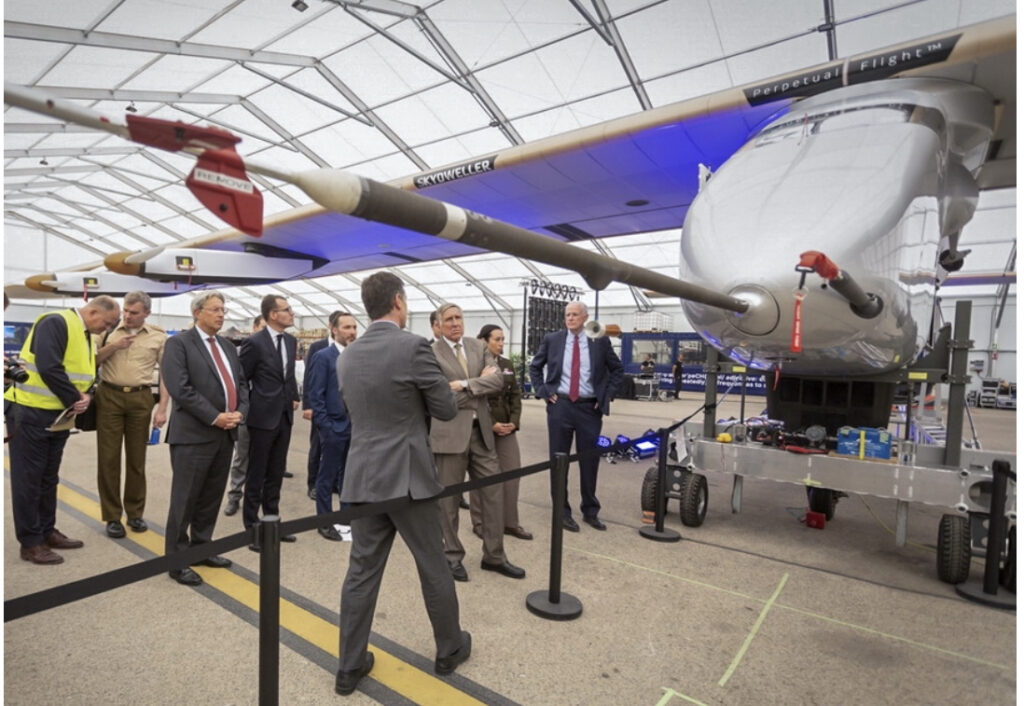U.S. AFRICA COMMAND EYES SKYDWELLER’S SOLAR-POWERED DRONE

The US military’s Africa Command is supporting the development of the Skydweller solar-powered aircraft that it sees being used by the US and partners to counter destabilizing, violent extremist activity in Africa.
The aircraft was displayed in Spain on 14 June, when civilian and military leaders from US Africa Command, France, Luxembourg and Spain gathered at the Albacete Air Base to formalise their support of a technology demonstration of the pilotless, carbon-neutral Skydweller airframe.
The aircraft should become capable of multi-month, continuous flight and has potential beyond gathering intelligence that supports US and partner-led efforts to counter destabilizing, violent extremist activity in Africa, Africom said.
“The bottom line is that a long duration and persistent ISR platform has the potential to provide a wide-range of capabilities to us…and our African partners at a lower cost while embracing a low carbon solution,” said Brigadier General Rose Keravuori, US Africa Command’s deputy director for intelligence.
The aircraft – the 10-year, old solar-powered Solar Impulse 2 – was acquired by Skydweller Aero (partly owned by Leonardo) and has been further developed and tested with US government support in Spain.
Skydweller is modelled after the Solar Impulse 2 that flew around the world in 2015 and 2016 using solar power, but will be pilotless. Removing the pilot will give estra payload capability. Skydweller will be able to fly at an altitude 14 000 metres, with up to 350 kg of surveillance equipment like radar and cameras.
“With long duration dwell, there is the potential for persistent monitoring of natural disasters to help provide better disaster response,” Keravuori said. “Our African partners would welcome persistent ISR (Intelligence, Surveillance and Reconnaissance) that can track piracy, receive indications of illicit trafficking, illegal oil bunkering, illegal poaching, or predator fishing.”
Speaking to the potential effects of climate change in Africa and how that change drives instability that is taken advantage of by adversaries to the detriment of societies, governments and people, Keravuori said the “added capability to monitor animal movements and the spread of desertification are especially critical as we monitor the signs of climate change.”
Development and implementation of the aircraft – better known for its solar-powered circumnavigation of the world in 2016 – attracted support from partner-nation dignitaries for the shared benefits of ending the aviation sector’s reliance on fossil fuel and allowing armed forces to approach security in an innovative, efficient way, Africom explained.
“I want to express our gratitude for the consistent and extensive support provided by our Spanish hosts,” Keravuori said. “We also want to thank the Government of Luxembourg for agreeing to transport the Skydweller prototype aircraft to an operational demo location in the Caribbean where we can learn more about its capabilities.”
The aircraft’s designers are working to make the Skydweller autonomous, and coupled with its tendency to perform better around the equator given weather patterns and exposure to sunlight, the Skydweller would be an ideal platform for use in Africa.
“Africom, along with the US Department of Defence’s Research and Engineering Branch and… Southcom (US Southern Command) are pleased to assist in the development of a carbon-neutral, long-dwell surveillance platform that can assist in generating greater security and development in partner countries,” Keravuori said. “We are interested in, and look forward to, exploring opportunities to coordinate with the military delegations present here today from France, Luxembourg and Spain.
Solar Impulse 2 is the brainchild of Swiss explorer Bertrand Piccard and Swiss engineer Bertrand Borschberg. After its record-breaking flight around the world, it was in 2019 bought by Skydweller Aero. After months of modifications, it flew again for the first time in November 2020. Since then, it has completed a dozen test flights in Spain and is in the process of turning it into a drone. The aircraft could be deployed as early as 2023.
Skydweller Aero hopes to offer the aircraft as a pseudo-satellite for commercial services, but has also received $5 million from the US Navy to investigate the aircraft’s ability to perform maritime patrols. The Defense Innovation Unit, tasked with developing emerging technology for the US military, has awarded Skydweller a $14 million contract, CNN reported.
